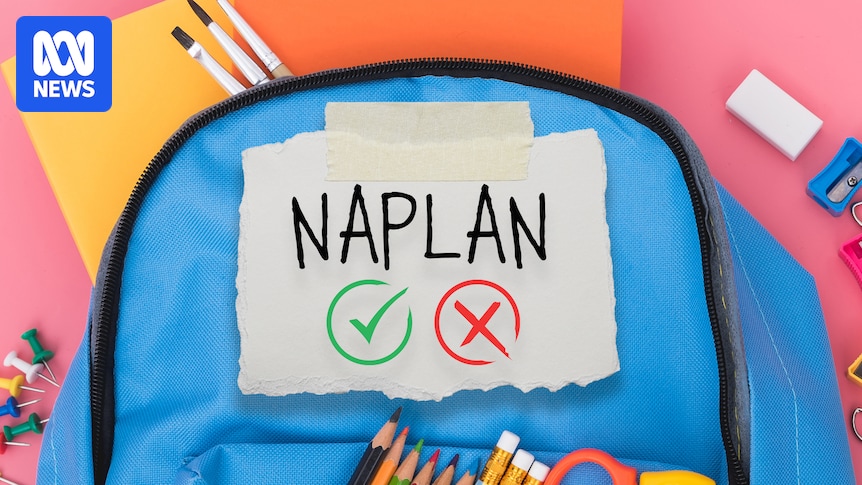One third of Australian students aren’t meeting “challenging but reasonable” expectations for literacy and numeracy following the third straight year of concerning NAPLAN results.
About 10 per cent of students are so far behind they require additional support to catch up to their peers, while another roughly one-fifth are rated as merely “developing” toward expectations.
“We’ve seen declines in student achievement despite significant investment in funding of the school system,” education analyst Glenn Fahey, from the Centre for Independent Studies, said.
In reading, on average 9.3 per cent of students were at the “needs additional support” levelIn numeracy, on average 9.2 per cent of students were at the “needs additional support” level.In writing, on average 9.4 per cent of students were at the “needs additional support” level
“Sadly, we don’t have the same level of demand from the public to lift school education as we do in virtually any other area of public policy.”
Mr Fahey is particularly concerned about the large number of students who need additional support, warning that many never catch up.
“This is a code red for your students’ achievement in school. Children who start behind and underachieve in NAPLAN have little to no chance of achieving at year level expectations by the time they finish school,” he said.
Glenn Fahey from the Centre for Independent Studies said children who start behind have little chance of meeting academic expectations by the time they finish school. (ABC News: Chris Taylor)
“We must demand urgency when it comes to school education, the time for incrementalism has passed, the lives of children are at risk when we get education wrong here in Australia.”
NAPLAN is an annual test of students in years 3, 5, 7 and 9 which aims to give a national snapshot as well as individual markers of progress in basic literacy and numeracy.
The agency that runs the test — the Australian Curriculum, Assessment and Reporting Authority (ACARA) — described the results as “broadly stable” but with some signs of improvement.
Stephen Gniel, from the Australian Curriculum Assessment and Reporting Authority, said the results showed some signs of improvement. (ABC News: Billy Draper)
“We want to obviously see students moving through those proficiency levels. We’ve seen some movement in the right direction in some of those areas this year, particularly in years 5, 7 and 9 in numeracy,” ACARA CEO Stephen Gniel said.
In reading, on average 68.2 per cent of students achieved at “strong” or “exceeding” levels. In numeracy, on average 66.8 per cent of students achieved at “strong” or “exceeding” levels.In writing, on average 66.6 per cent of students achieved at “strong” or “exceeding” levels.
However, ACARA highlighted persistent trends that have seen Indigenous, remote and rural students, and those from disadvantaged backgrounds lagging well behind their peers.
“At a national level, we need to continue to put our collective attention and collective action towards supporting those students in regional and remote schools,” Mr Gniel said.
One third of Australian students aren’t meeting expectations for literacy and numeracy. (ABC News: Evan Young)
“Disproportionately, as well as our kids from disadvantaged backgrounds, our Indigenous kids, there’s still areas for us to focus on, and NAPLAN points that out.”
New teaching resources launched to tackle ’30-year policy failure’
Education Minister Jason Clare noted the improvements in some areas but said a new $16 billion public school funding deal was tied to reforms to lift performance.
“The improvements in literacy and numeracy are good news, but there’s more work to do,” he said.
“That’s what the new agreements we’ve now signed with every state and territory are all about. They’re the biggest investment by the Australian government in public schools ever, and this is not a blank cheque. This funding is tied to real and practical reforms.”
NAPLAN backlash
However, many education academics are concerned that reporting on NAPLAN is “overblown” and contributing to chronic shortages of teachers.
Dr Fiona Longmuir from Monash University said the challenges around NAPLAN were damaging for teacher morale. (ABC News: Billy Draper)
“Teachers are hearing all of these stories, all of these big challenges, you know ‘NAPLAN is a disaster’ and it’s damaging their motivation and morale,” said Dr Fiona Longmuir from Monash University.
“At a school level and a classroom level, arguably, its value is pretty limited.”
Dr Sally Larsen from the University of New England said national snapshots of students ranked in the “developing” category may not capture whether they are making progress with that band.
“Students’ skills will develop over the course of their schooling, as they grow older and gain more schooling experience,” Dr Larsen said.
Dr Sally Larsen from the University of New England said NAPLAN didn’t capture the full range of students’ learning. (Supplied)
“If a student is in the developing proficiency level, it means they are working towards expectations — in other words, they are making progress, and will continue to do so with more time in school, expert teachers and targeted support.”
Dr Larsen also said NAPLAN does not capture the full range of learning happening in Australian schools.
“NAPLAN assesses only literacy and numeracy skills of children from Year 3 to Year 9. While these are important and foundational skills for many other academic domains, literacy and numeracy are not the only important areas of learning in schools,” Dr Larsen said.
“What about creative arts? History? Music? Physical Education? Drama? Even science is not a central focus of annual NAPLAN testing.”
Individual students have already received their NAPLAN results, but school-by-school breakdowns won’t be available until December.
The NAPLAN standards
Exceeding: Exceeds expectations at the time of testing
Strong: Meets challenging but reasonable expectations at the time of testing
Developing: Indicates the student is working towards expectations at the time of testing
Needs additional support: Indicates student is not achieving the learning outcomes expected at the time of testing and is likely to need help to progress

